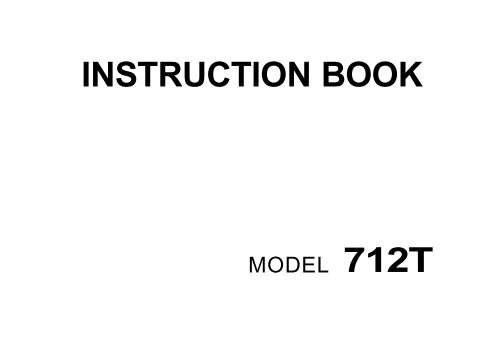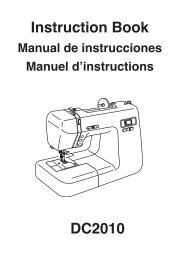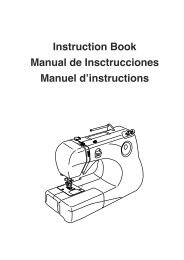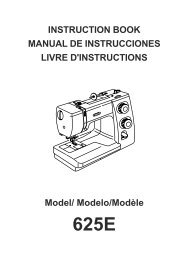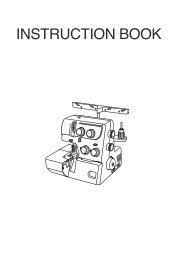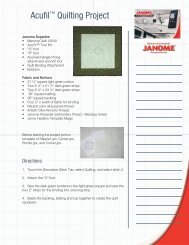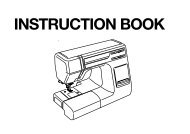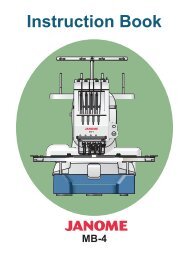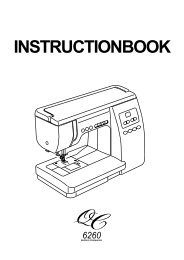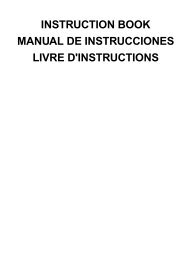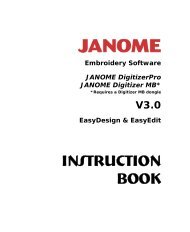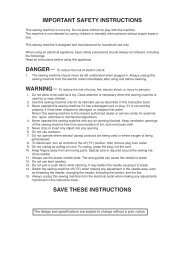INSTRUCTION BOOK - Janome
INSTRUCTION BOOK - Janome
INSTRUCTION BOOK - Janome
Create successful ePaper yourself
Turn your PDF publications into a flip-book with our unique Google optimized e-Paper software.
<strong>INSTRUCTION</strong> <strong>BOOK</strong><br />
MODEL 712T
SECTION I ESSENTIAL PARTS<br />
Names of Parts ...................................................................... 2 ~ 3<br />
Standard Accessories ...................................................................3<br />
How to Install the Spool Pin ..........................................................4<br />
Fundamentals of Operation ..........................................................4<br />
SECTION II GETTING READY TO SEW<br />
Thread and Needle Chart .............................................................5<br />
Changing Needles ........................................................................6<br />
Raising or Lowering the Presser Foot ...........................................7<br />
To Detach and Attach the Foot Holder .........................................7<br />
To Snap the Presser Foot On and Off ..........................................7<br />
Removing the Bobbin ....................................................................8<br />
Setting Spool .................................................................................8<br />
Winding the Bobbin .......................................................................9<br />
Inserting the Bobbin ....................................................................10<br />
Threading the Machine ...............................................................11<br />
Drawing up Bobbin Thread .........................................................12<br />
Balancing Needle Thread Tension ..............................................12<br />
* Auto-tension ..........................................................................12<br />
* Manual Needle Thread Tension ...........................................12<br />
Pattern Selector Dial ...................................................................13<br />
Stitch Length Dial ........................................................................13<br />
* Selecting Stitch Length .........................................................13<br />
* Selecting Stretch Stitch Patterns ..........................................13<br />
TABLE OF CONTENTS<br />
Dropping the Feed Dogs .............................................................14<br />
Reverse Stitch Lever ...................................................................14<br />
SECTION III SEWING<br />
Straight Stitch ..................................................................... 15 ~ 16<br />
Zigzag Stitch ...............................................................................16<br />
Overcasting .................................................................................17<br />
Triple Stitch .................................................................................17<br />
Blind Hemming ............................................................................18<br />
Buttonhole .......................................................................... 19 ~ 20<br />
Tricot Stitch .................................................................................20<br />
Zipper Application .............................................................. 21 ~ 22<br />
Feather Stitch ..............................................................................23<br />
Stretch Stitch Patterns ................................................................23<br />
Rolled Hem .................................................................................24<br />
SECTION IV CARE OF YOUR MACHINE<br />
Cleaning the Bobbin Holder ........................................................25<br />
Cleaning the Hook Race and Feed Dog ............................ 25 ~ 26<br />
Resetting the Bobbin Holder and Needle Plate ..........................26<br />
Oiling the Machine ......................................................................27<br />
Troubleshooting ................................................................. 28 ~ 29<br />
1
• Names of Parts<br />
2<br />
1.<br />
2.<br />
3.<br />
4.<br />
5.<br />
6.<br />
7.<br />
8.<br />
9.<br />
10<br />
11.<br />
12.<br />
13.<br />
14.<br />
15.<br />
16.<br />
17.<br />
18.<br />
19.<br />
20.<br />
21.<br />
22.<br />
Reverse stitch lever<br />
Stitch length dial<br />
Bobbin winder stopper<br />
Bobbin winder spindle<br />
Spool pin<br />
Pattern selector dial<br />
Thread tension dial<br />
Bobbin winder thread guide<br />
Upper thread guide<br />
Thread take-up lever<br />
Face plate<br />
Thread cutter<br />
Presser bar<br />
Foot holder<br />
Thumb screw<br />
Feed dog<br />
Needle plate<br />
Bobbin<br />
Needle clamp<br />
Needle clamp screw<br />
Needle<br />
Slide plate<br />
!1<br />
o<br />
!2<br />
SECTION l ESSENTIAL PARTS<br />
!0<br />
i<br />
u<br />
y<br />
t<br />
!3<br />
!4<br />
!5<br />
!6<br />
!7<br />
!8<br />
r<br />
!9<br />
e<br />
w<br />
q<br />
@0<br />
@1<br />
@2
@3<br />
@4<br />
23.<br />
24.<br />
25.<br />
Handwheel<br />
Stop motion knob<br />
Presser foot lifter<br />
@5<br />
• Standard Accessories<br />
Screwdriver Seam ripper Lint brush<br />
Bobbins Set of needles Oil<br />
E: Zipper foot D: Hemmer foot C: Overedge foot<br />
J: Sliding buttonhole foot G: Blind stitch foot<br />
3
• How to Install the Spool Pin • Fundamentals of Operation<br />
4<br />
Setscrews<br />
Spool pin and two setscrews are packed separately to prevent<br />
damage in transit.<br />
After unpacking, attach the spool pin holder with a screwdriver,<br />
as shown in illustration.<br />
For Your Safety<br />
1. While in operation, always keep your eyes on the needle,<br />
and do not touch any moving parts such as the take-up lever,<br />
handwheel or needle.<br />
2. Do not run the machine:<br />
* When making any adjustment in the needle area, such as<br />
threading needle, changing needle, or threading bobbin,<br />
etc.<br />
* When attaching or removing parts.<br />
* When cleaning the machine.<br />
Before Using the Machine<br />
• Wipe the machine with a clean cloth to remove any dust or oil.<br />
• To replace presser foot and needle, follow the guides in the<br />
instruction book.<br />
• When setting up the machine for sewing, test the stitches on a<br />
small piece of the fabric with the threads that will be used for<br />
actual sewing.<br />
For Longer Life of the Machine<br />
• Do not expose the machine to direct sunlight for long periods<br />
of time.<br />
• Do not store the machine in an area of high humidity.<br />
• Handle the machine with care to avoid dropping or bumping.
• Thread and Needle Chart<br />
Light<br />
weight<br />
Medium<br />
weight<br />
Heavy<br />
weight<br />
Fabrics Threads<br />
Crepe de Chine, Voile<br />
Lawn, Organdy, Georgette,<br />
Tricot<br />
Linens, Cotton, Pique,<br />
Serge, Double Knits,<br />
Percale<br />
Denim, Tweed, Gabardine,<br />
Coating, Drapery and<br />
Upholstery Fabric<br />
SECTION II GETTING READY TO SEW<br />
Fine Silk<br />
Fine Cotton<br />
Fine Synthetic<br />
Fine Cotton Covered<br />
Polyester<br />
50 Silk<br />
50 to 80 Cotton<br />
50 to 60 Synthetic<br />
Cotton Covered<br />
Polyester<br />
50 Silk<br />
40 to 50 Cotton<br />
40 to 50 Synthetic<br />
Cotton Covered<br />
Polyester<br />
Needle Size<br />
9<br />
or<br />
11<br />
11<br />
or<br />
14<br />
14<br />
or<br />
16<br />
• In general, fine thread and<br />
needles are used for sewing<br />
thin fabrics, and thicker<br />
threads and needles are<br />
used for sewing heavy<br />
fabrics.<br />
Always test thread and<br />
needle size on a small piece<br />
of fabric which will be used<br />
for actual sewing.<br />
• Use the same thread for<br />
needle and bobbin.<br />
( To Select a Suitable Needle)<br />
BLUE TIPPED needle<br />
Stem<br />
• When sewing stretch, very<br />
fine fabric or synthetics, use<br />
a BLUE TIPPED needle.<br />
The blue tipped needle<br />
effectively prevents skipped<br />
stitches.<br />
• When sewing very fine<br />
fabrics, use a piece of<br />
stabilizer to prevent thread<br />
distortion.<br />
* A number indicating the size<br />
of needle is marked on the<br />
stem.<br />
The higher the number, the<br />
thicker the needle.<br />
* A BLUE TIPPED needle is<br />
supplied with the machine.<br />
* Do not use any needle<br />
which is bent or blunt.<br />
5
• Changing Needles<br />
6<br />
Needle clamp<br />
Needle clamp screw<br />
Raise the needle by turning the handwheel toward you and lower<br />
the presser foot.<br />
Loosen the needle clamp screw by turning it toward you.<br />
Remove the needle from the clamp.<br />
Insert the new needle into the needle clamp with the flat side<br />
facing to the back.<br />
When inserting the needle into the clamp, push it up as far as it<br />
will go and tighten the clamp screw firmly with the screwdriver.
• Raising or Lowering the Presser Foot • To Snap the Presser Foot On and Off<br />
The presser foot lifter raises or lowers your presser foot.<br />
• To Detach and Attach the Foot Holder<br />
Thumb screw<br />
<br />
Remove the thumb screw by<br />
turning it counter clockwise<br />
with the screwdriver.<br />
Presser foot lifter<br />
Foot holder<br />
Thumb screw<br />
<br />
Match the hole in the foot<br />
holder with the threaded hole<br />
in the presser bar.<br />
Fit the thumb screw into the<br />
hole.<br />
Tighten the thumb screw by<br />
turning it clockwise.<br />
q<br />
w<br />
Groove<br />
Red<br />
button<br />
Pin<br />
q Press the red button on<br />
the back of the foot<br />
holder.<br />
The presser foot will<br />
drop off.<br />
w Place the presser foot<br />
so the pin on the foot<br />
lies just under the<br />
groove of the foot<br />
holder.<br />
Lower the presser foot<br />
lifter to lock the foot in<br />
place.<br />
7
• Removing the Bobbin • Setting Spool<br />
8<br />
q<br />
w<br />
Slide plate<br />
q Gently push the slide<br />
plate down and slide<br />
it toward you.<br />
w Lift out the bobbin, as<br />
shown.<br />
q Turn the spool pin.<br />
w Set the spool from the bottom end of the spool pin as<br />
illustrated.<br />
q<br />
e<br />
e Return the spool pin to its original position.<br />
w
• Winding the Bobbin<br />
e<br />
i<br />
Bobbin winder<br />
thread guide<br />
q<br />
Stop motion<br />
knob<br />
w Draw the thread from the spool.<br />
q Turn the stop motion<br />
knob counterclockwise to<br />
disengage clutch.<br />
e Guide the thread around the bobbin winder thread guide.<br />
r<br />
t<br />
y<br />
u<br />
r Insert the thread through the hole in<br />
the bobbin from inside to outside as<br />
shown.<br />
t Put the bobbin on the bobbin winder<br />
spindle, and push it to the right.<br />
y While holding the free end of the<br />
thread with your hand, pedal the<br />
machine. Stop the machine when the<br />
bobbin has made a few turns, and cut<br />
the thread close to the hole in the<br />
bobbin.<br />
u Pedal the machine and wind the<br />
thread until the bobbin stops. Move<br />
the bobbin winder spindle to its<br />
original position (left), and cut the<br />
thread.<br />
i Turn the stop motion knob clockwise<br />
to engage clutch.<br />
* The machine will not sew until the<br />
stop motion knob is tightened.<br />
9
• Inserting the Bobbin<br />
q<br />
w<br />
10<br />
q Place the bobbin in the<br />
bobbin holder with the<br />
thread end unwinding in the<br />
clockwise direction.<br />
w Guide the thread into the<br />
notch “A” on the front side<br />
of the bobbin holder.<br />
Draw the thread to the left,<br />
sliding it between the<br />
tension spring blades.<br />
e<br />
r<br />
Threading chart<br />
e Continue to draw the<br />
thread lightly until the<br />
thread slips into notch “B”.<br />
Pull out about 15 cm (6˝) of<br />
thread.<br />
r Close the slide plate.<br />
Check the threading by<br />
referring to the chart shown<br />
on the slide plate.
• Threading the Machine<br />
q<br />
e<br />
r<br />
t<br />
y<br />
q<br />
w<br />
w<br />
e<br />
r<br />
t<br />
y<br />
Raise the thread take-up lever to its highest position by turning the<br />
handwheel towards you. Raise the presser foot with the presser foot<br />
lifter and pass the thread in the order from q to y.<br />
q Draw the thread into the thread guide using both hands.<br />
w While holding the thread near the spool, draw the thread down<br />
into the tension area and then around the check spring holder.<br />
e Firmly draw the thread from right to left over the take-up lever and<br />
down into the take-up lever eye.<br />
r Then draw the thread down and slip it into the lower thread guide.<br />
t Draw the thread down and slip it into the needle bar thread guide<br />
on the left.<br />
y Thread the needle eye from front to back.<br />
NOTE: You may want to cut the end of the thread with sharp<br />
scissors for easier needle threading.<br />
11
• Drawing up Bobbin Thread • Balancing Needle Thread Tension<br />
q<br />
w<br />
e<br />
12<br />
q Raise the presser foot and<br />
hold the needle thread<br />
lightly with your left hand.<br />
w Turn the handwheel towards<br />
you with your right hand<br />
until the needle goes down,<br />
and continue to turn the<br />
handwheel until the take-up<br />
lever is at its highest<br />
position. Lightly pull on the<br />
needle thread to draw up a<br />
loop of the bobbin thread.<br />
e Pull 15 cm (6˝) of both<br />
threads back and under the<br />
presser foot.<br />
* Auto-tension<br />
Set “AUTO” for ordinary sewing to get well-balanced tension.<br />
° For Straight Stitch<br />
Bobbin thread<br />
Setting mark<br />
The ideal straight stitch will have threads locked between<br />
the two layers of fabric.<br />
° For Zigzag Stitch<br />
Needle thread<br />
In the correct zigzag stitch, the bobbin threads will not<br />
show on the right side of fabric and the needle threads<br />
will show slightly on the wrong side of fabric.<br />
* Manual Needle Thread Tension<br />
Loosen the needle thread<br />
tension by moving the dial to<br />
a lower number.<br />
Tighten the needle thread<br />
tension by moving the dial to<br />
a higher number.
• Pattern Selector Dial • Stitch Length Dial<br />
Setting mark<br />
1 ~ 4<br />
Turn the handwheel with<br />
your hand until the tip of<br />
needle is out of fabric.<br />
Select the stitch by turning<br />
the pattern selector dial.<br />
NOTE: Do not turn the pattern selector dial while needle is in<br />
material.<br />
Pattern<br />
Stitch length<br />
dial<br />
Stretch stitch<br />
patterns<br />
Stitch length<br />
dial<br />
0.3<br />
~ 4 0.5<br />
~ 2<br />
S. S.<br />
1 ~ 3<br />
2 ~ 3<br />
* Selecting Stitch Length<br />
* Selecting Stretch Stitch Patterns<br />
q w<br />
The higher the number, the longer<br />
the stitch length.<br />
You can select the suitable stitch<br />
length for most fabrics.<br />
When sewing stretch stitch, set the<br />
length dial at “S.S.”.<br />
If forward and reverse feeds become<br />
unbalanced due to the type of fabric,<br />
correct the balance as follows:<br />
When patterns are compressed,<br />
correct it by turning the dial in the<br />
direction q so that the setting mark<br />
indicates “S.S.” to “+” .<br />
When patterns are drawn out,<br />
correct it by turning the dial in the<br />
direction w so that the setting mark<br />
indicates “S.S.” to “–”.<br />
13
• Dropping the Feed Dogs<br />
14<br />
To drop the feed dogs, turn the stitch<br />
length dial to the “ ” mark.<br />
• Reverse Stitch Lever<br />
Reverse stitch lever<br />
Fabric is fed in reverse while the lever is<br />
pressed. When it is released, fabric is fed<br />
forward.
• Straight Stitch<br />
or<br />
Machine Setting<br />
Stitch Length<br />
1.5 ~ 4<br />
><br />
A: Zigzag Foot<br />
While holding the threads with<br />
your left hand, turn the handwheel<br />
toward you to bring the needle into<br />
the fabric where you wish to start<br />
sewing.<br />
Lower the presser foot, and then<br />
start sewing slowly.<br />
SECTION III SEWING<br />
q<br />
w<br />
<br />
q Bring the needle down into the<br />
fabric, and raise the presser<br />
foot.<br />
w Then pivot the fabric to the<br />
desired direction. Lower the<br />
foot to start sewing.<br />
15
16<br />
qw<br />
e<br />
<br />
q For fastening the end of<br />
seams, press the reverse<br />
stitch lever and sew several<br />
reverse stitches.<br />
w Turn the handwheel so that<br />
the take-up lever is at its<br />
highest position. Raise the<br />
presser foot and draw the<br />
fabric out to the rear.<br />
e Cut the threads with the<br />
thread cutter, leaving the<br />
thread ends the proper length<br />
for starting the next seam.<br />
• Zigzag Stitch<br />
Machine Setting<br />
Stitch Length<br />
0.3 ~ 4<br />
A: Zigzag Foot<br />
Zigzag width can be adjusted within<br />
the range illustrated by the symbol.
• Overcasting • Triple Stitch<br />
Guide<br />
Edge of fabric<br />
Machine Setting<br />
Stitch Length<br />
Here’s How<br />
C: Overedge Foot<br />
Place the fabric under the presser<br />
foot so that the stitches are made<br />
over the edge.<br />
NOTE: When using stretch knit<br />
fabric, use a blue tip<br />
needle, which effectively<br />
prevents skipped stitches.<br />
or<br />
Machine Setting<br />
Stitch Length<br />
S. S.<br />
A: Zigzag Foot<br />
This stitch is formed with two<br />
stitches forward and one stitch<br />
backward. Because of this, the<br />
seam is very strong and cannot<br />
be ripped out easily. Garments<br />
should be basted for fitting before<br />
using this stitch.<br />
17
• Blind Hemming<br />
18<br />
or<br />
<br />
Wrong side<br />
of fabric<br />
Machine Setting<br />
0.4 to 0.7 cm<br />
(5/32 to 9/32˝)<br />
Stitch Length<br />
1 ~ 3<br />
Wrong side<br />
of fabric<br />
Light weight fabric Heavy weight fabric<br />
G: Blind Stitch Foot<br />
0.4 to 0.7 cm<br />
(5/32 to 9/32˝)<br />
On heavy weight fabrics that ravel, the raw edge should be<br />
overcast first. On lightweight fabrics the raw edge can be turned<br />
under and pressed.<br />
Fold the hem the desired amount and pin in place.<br />
Fold hem under the fabric as illustrated.<br />
<br />
q<br />
When the<br />
needle<br />
comes to<br />
the left.<br />
When the<br />
needle<br />
comes to<br />
the right.<br />
q Position the fabric on the<br />
machine so that the needle<br />
just pierces the folded edge<br />
of the fabric when the<br />
needle comes over to the<br />
extreme left side. Lower the<br />
presser foot.<br />
<br />
w<br />
Guide<br />
screw<br />
Sliding guide<br />
w Turn the guide screw and<br />
move the sliding guide<br />
against the folded edge.<br />
Sew the folded edge<br />
guiding along the sliding<br />
guide.<br />
Needle<br />
Guide screw<br />
Sliding guide
• Buttonhole<br />
Machine Setting<br />
Stitch Length<br />
Red zone<br />
(0.3 – 1)<br />
J: Sliding buttonhole<br />
foot<br />
Always make a practice buttonhole on a scrap of fabric you plan<br />
to use. Try the buttonhole with the button you will use.<br />
The symbol “ ” (red zone) on the stitch<br />
length dial indicates the range of adjustment<br />
for the buttonhole.<br />
To adjust for coaser stitch for the buttonhole,<br />
turn the dial toward "1". For denser stitch for<br />
the buttonhole, turn the dial toward "0".<br />
qwe r<br />
q Set the pattern selector dial<br />
at “ ”.<br />
w Lead both threads to the left.<br />
e Lower the needle into the<br />
fabric, where the buttonhole<br />
is to start, and lower the foot.<br />
t<br />
t Set the pattern selector dial<br />
at “ ”, and sew 5 stitches<br />
of bartack, then raise the<br />
needle from the fabric.<br />
r Sew down the left side of the<br />
buttonhole to the bottom<br />
end. Raise the needle.<br />
y<br />
y Set the pattern selector dial<br />
at “ ”. Sew the right side<br />
of the buttonhole. Stop the<br />
machine when you are<br />
directly opposite the first<br />
stitch on the left side, and<br />
raise the needle.<br />
19
u<br />
i<br />
20<br />
u Set the pattern selector dial<br />
at “ ”.<br />
Sew 5 stitches of bartack,<br />
and raise the needle from<br />
the fabric.<br />
Then set the pattern<br />
selector dial at “ ” and<br />
sew a few stitches to<br />
secure the seam.<br />
i Remove the fabric from the<br />
machine, and cut the<br />
sewing threads.<br />
Pierce a pin inside the<br />
bartack. Then cut the<br />
opening with a seam ripper.<br />
Be careful not to cut the<br />
stitches.<br />
• Tricot Stitch<br />
Machine Setting<br />
Stitch Length<br />
0.5 ~ 2<br />
A: Zigzag Foot<br />
The tricot stitch is used to finish<br />
seam allowance on synthetics<br />
and other fabrics that tend to<br />
pucker.<br />
The stitch is excellent for<br />
darning and mending tears in<br />
fabric as well.
• Zipper Application<br />
Right<br />
side of<br />
fabric<br />
Machine Setting<br />
End of opening<br />
Top edge of fabric<br />
<br />
Stitch Length<br />
1.5 ~ 4<br />
E: Zipper Foot<br />
Put the right side of the fabric together and sew to the end of<br />
the zipper opening. Use the reverse to lock the stitches.<br />
Baste the zipper opening with stitch length at “4” and top thread<br />
tension at “3”.<br />
0.2~0.3 cm<br />
Wrong<br />
side of<br />
fabric<br />
qwe<br />
The pin on the<br />
left hand side<br />
Zipper teeth<br />
Zipper tape<br />
<br />
• To sew on the left side of the<br />
zipper, attach the zipper foot<br />
with the pin on the right hand<br />
side.<br />
• To sew on the right side of<br />
the zipper, attach the zipper<br />
foot with the pin on the left<br />
hand side.<br />
<br />
q Set the stitch length at 2 and<br />
the top thread tension at<br />
“AUTO”. Fold back the left<br />
seam allowance as shown.<br />
w Turn under the right seam<br />
allowance to form a 0.2 to<br />
0.3 cm (1/8˝) fold.<br />
e Place the zipper teeth next<br />
to the 0.2 to 0.3 cm (1/8˝)<br />
fold with the bottom end of<br />
the zipper matching the<br />
bottom end of the zipper<br />
opening. Pin in the place.<br />
21
Attach the zipper foot with<br />
the pin on the right hand<br />
side.<br />
t Lower the zipper foot at<br />
the bottom of the zipper so<br />
that the needle pierces the<br />
fold and the zipper tape.<br />
Wrong side<br />
of fabric<br />
y Sew through the fold and<br />
the zipper tape to the point<br />
rtyu where the slider begins.<br />
u Lower the needle to hold<br />
the fabric and raise the<br />
presser foot.<br />
!1 !2 !3 !4 !5 !6<br />
22<br />
Wrong side<br />
of fabric<br />
io<br />
Wrong<br />
side<br />
of fabric<br />
!0<br />
Right<br />
side<br />
of fabric<br />
Right<br />
side<br />
of fabric<br />
i Open the zipper.<br />
o Lower the presser foot and<br />
stitch the rest of the seam.<br />
!0 Close the zipper<br />
and turn the<br />
fabric right side<br />
up.<br />
!7<br />
!1 Remove the zipper foot and<br />
attach the zipper foot with<br />
the pin on the left hand side.<br />
!2 Stitch across the bottom of<br />
zipper, below the zipper<br />
end.<br />
!3 Turn the corner and<br />
continue to guide the foot<br />
along the zipper teeth, as<br />
shown. Stitch through the<br />
fabric and zipper tape.<br />
!4 Stop about 5 cm from the<br />
top of the zipper.<br />
!5 Lower the needle into the<br />
fabric and raise the presser<br />
foot.<br />
!6 Remove the basting stitches<br />
and open the zipper.<br />
!7 Lower the foot and stitch the<br />
rest of the seam. Make sure<br />
the fold is even.
• Feather Stitch • Stretch Stitch Patterns<br />
Machine Setting<br />
Stitch Length<br />
S. S.<br />
A: Zigzag Foot<br />
Place right sides of fabric<br />
together and seam along<br />
the edge.<br />
Spread the fabric open flat<br />
with the right side of the<br />
fabric facing up.<br />
Sew feather stitch slowly<br />
guiding the fabric so the<br />
needle catches the folded<br />
edge on each side.<br />
Machine Setting<br />
Stitch Length<br />
S. S.<br />
A: Zigzag Foot<br />
q w<br />
When forward and reverse feeds become unbalanced due to<br />
the type of fabric, correct the balance by turning the stitch length<br />
dial as follows:<br />
When patterns are compressed, correct it by turning the dial in<br />
the direction q.<br />
When patterns are drawn out, correct it by turning the dial in the<br />
direction w.<br />
23
• Rolled Hem<br />
24<br />
Machine Setting<br />
Stitch Length<br />
1.5 ~ 4<br />
D: Hemmer Foot<br />
Make a double 0.25 cm (1/8˝) fold<br />
approximately 8 cm (3˝) in length.<br />
Lower the needle into the fabric at<br />
the point where sewing is to begin,<br />
then lower the hemmer foot.<br />
Sew 3 or 4 stitches while pulling the<br />
needle and bobbin threads.<br />
0.7cm (1/4˝)<br />
0.7cm (1/4˝)<br />
Lower the needle into the<br />
fabric and lift the hemmer foot.<br />
Insert the folded portion of the<br />
fabric into the curl of the<br />
hemmer foot.<br />
Lower the hemmer foot, and<br />
then sew by lifting up the edge<br />
of the fabric to keep it feeding<br />
smoothly and evenly.<br />
To reduce bulk, trim about<br />
0.7 cm (1/4˝) from corners as<br />
illustrated.
q<br />
w<br />
SECTION IV CARE OF YOUR MACHINE<br />
* Before cleaning, turn the<br />
handwheel toward you to<br />
raise the needle.<br />
• Cleaning the Bobbin<br />
Holder<br />
q While pushing the front end<br />
of slide plate, slide it toward<br />
you as far as it will go.<br />
w Take out the bobbin, and<br />
remove lint with a lint<br />
brush.<br />
e Insert the bobbin.<br />
r Close the slide plate.<br />
er e<br />
q<br />
w<br />
Setscrew<br />
• Cleaning the Hook Race<br />
and Feed Dog<br />
q Remove the needle and<br />
presser foot. Remove the<br />
setscrew on the left hand<br />
side of the needle plate<br />
with the screwdriver.<br />
Remove the needle plate.<br />
w Take out the bobbin.<br />
e Lift up the front end of<br />
bobbin holder to remove it.<br />
25
t<br />
26<br />
r Brush off the lint on the<br />
feed dogs.<br />
t Wipe the hook race with a<br />
soft dry cloth.<br />
y Clean the bobbin holder<br />
with a lint brush and a soft<br />
dry cloth.<br />
y e<br />
Triangle<br />
marks<br />
q<br />
w<br />
Setscrew<br />
Stopper<br />
Knob<br />
• Resetting the Bobbin<br />
Holder and Needle Plate<br />
q Line up the triangle marks<br />
and position the bobbin<br />
holder so that the knob fits<br />
next to the stopper in the<br />
hook race.<br />
w Put the bobbin in.<br />
e Attach the needle plate with<br />
setscrew. Insert the needle,<br />
and attach the presser foot.
• Oiling the Machine<br />
For a machine in constant use, oil two or three times a year.<br />
If the machine does not work smoothly due to standing idle for some time,<br />
apply a few drops of oil at the oiling points, and run the machine rapidly for<br />
a minute.<br />
Wipe excess oil before sewing.<br />
Unscrew and remove the face plate.<br />
Apply a few drops of fine quality sewing machine oil to the points indicated<br />
by the arrows in the illustration.<br />
Remove the two screws and take off the top cover.<br />
Apply a few drops of fine quality sewing machine oil to the points indicated<br />
by the arrows in the illustration.<br />
Lay the machine over on its back and apply a few drops of fine quality<br />
sewing machine oil to the points indicated by the arrows in the illustration.<br />
27
• Troubleshooting<br />
28<br />
Condition<br />
The machine does not run<br />
smoothly and is noisy.<br />
The needle thread breaks.<br />
The bobbin thread breaks.<br />
The needle breaks<br />
Skipped stitches<br />
Cause<br />
1. Threads have been caught in hook mechanism.<br />
2. The feed dog is packed with lint.<br />
1. The needle thread is not threaded properly.<br />
2. The needle thread tension is too tight.<br />
3. The needle is bent or blunt.<br />
4. The needle is incorrectly inserted.<br />
5. The fabric is not being drawn to the back when sewing is finished.<br />
6. The thread is either too heavy or too fine for the needle.<br />
1. The bobbin thread is not threaded properly in the bobbin holder.<br />
2. Lint has collected in the bobbin holder and/or tension spring.<br />
3. The bobbin does not rotate smoothly.<br />
1. The needle is incorrectly inserted.<br />
2. The needle is bent or blunt.<br />
3. The needle clamp screw is loose.<br />
4. The tension of the needle thread is too tight.<br />
5. The fabric is not drawn to the back when sewing is finished.<br />
6. The needle is too fine for the fabric being sewn.<br />
7. The pattern selector dial had been turned while the needle was in the<br />
material.<br />
1. The needle is incorrectly inserted.<br />
2. The needle is bent or blunt.<br />
3. The needle and/or threads are not suitable for the work being sewn.<br />
4. A BLUE TIP needle is not used for sewing stretch, very fine fabrics and<br />
synthetics.<br />
5. The needle thread is not threaded properly.<br />
Reference<br />
See Pages 25 ~ 26<br />
See Page 11<br />
See Page 12<br />
See Page 5<br />
See Page 6<br />
See Page 16<br />
See Page 5<br />
See Page 10<br />
See Pages 25 ~ 26<br />
Replace the bobbin.<br />
See Page 6<br />
See Page 5<br />
See Page 6<br />
See Page 12<br />
See Page 16<br />
See Page 5<br />
See Page 13<br />
See Page 6<br />
See Page 5<br />
See Page 5<br />
See Page 5<br />
See Page 11
Condition<br />
Seam Puckering<br />
Stitches form loops below<br />
the work.<br />
The cloth is not feeding<br />
smoothly.<br />
The machine does not<br />
work.<br />
The buttonhole stitches<br />
are not balanced.<br />
The machine is noisy.<br />
Cause<br />
1. The needle thread tension is too tight.<br />
2. The needle thread and/or bobbin thread is not threaded properly.<br />
3. The needle is too heavy for the cloth being sewn.<br />
4. The stitches are too coarse for the fabric being sewn.<br />
* When sewing extremely lightweight materials, place a sheet of paper<br />
underneath the fabric.<br />
1. The needle thread tension is too loose.<br />
2. The needle is either too heavy or too fine for the thread.<br />
3. The needle thread is not threaded properly.<br />
1. The feed dog is packed with lint.<br />
2. The stitches are too fine.<br />
3. The feed dog is not raised after “Drop feed” has been used.<br />
1. A thread is caught in the hook race.<br />
2. Stop motion knob is not tightened.<br />
1.The stitch length is not suitable for the fabric being sewn.<br />
2. The work is being pulled or held back.<br />
1. The machine is in need of oil.<br />
2. Dust and lint have collected in the hook mechanism.<br />
3. The feed dog is packed with lint.<br />
Reference<br />
See Page 12<br />
See Pages 10 ~ 11<br />
See Page 5<br />
See Page 13<br />
See Page 12<br />
See Page 5<br />
See Page 11<br />
See Pages 25 ~ 26<br />
See Page 13<br />
See Page 14<br />
See Pages 25 ~ 26<br />
See Page 9<br />
See Page 13<br />
Do not force the fabric<br />
for guiding.<br />
See Page 27<br />
See Pages 25 ~ 26<br />
See Pages 25 ~ 26<br />
29
749-800-011 (E-N)<br />
Printed in Taiwan
To operate the machine, a treadle operated sewing table is required.<br />
“INSTALLATION <strong>INSTRUCTION</strong>S”<br />
1. Lay the machine backwards with bottom towards you and loosen setscrews.<br />
2. After loosening set screws, position and set the machine onto hinges.<br />
3. Tighten setscrews and swing the machine forward into place.<br />
Setscrew<br />
Hinge<br />
Hinge<br />
Bottom view of machine showing the position of setscrews<br />
Setscrew<br />
To install the machine onto a sewing table, refer to the instructions<br />
with your sewing table for more details.


